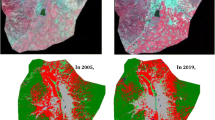Abstract
In the past few years, due to the vigorous development of China’s industry and the rapid increase in urbanization, a series of adverse effects have been produced, such as the decline of groundwater levels, the pollution of groundwater resources, and the degradation of wetlands. Real-time monitoring of changes in groundwater volume and water quality under the influence of human activities is very important in the current era. It is not only of great significance for achieving sustainable development, but also indispensable for future specific planning. This paper mainly optimizes the design of the monitoring well pattern from the Yukou landfill to the water source of Zhongqiao in P District and establishes three optimization goals of pollution detection probability, early warning response time, and cost. Firstly, the deterministic model of P area was established by image super-resolution processing, and the pollution source was tracked by the software package MODPATH in GMS, so that the early warning response time occupies the primary position in the optimization goal. The first optimization plan was proposed, using Monte Carlo. The method randomizes the parameters of the permeability coefficient K and establishes a random model. Using the risk analysis in the random model, the probability capture area of the mining well at the water source is obtained. The probability of pollution detection takes the first place in the optimization objective. Taking the pollution detection probability as the primary position in the optimization objective, the second optimization scheme is proposed. Through the research on groundwater resource pollution detection and home sports training intervention, we will apply it to real life and promote its rapid development in the future.








Similar content being viewed by others
Change history
15 November 2021
This article has been retracted. Please see the Retraction Notice for more detail: https://doi.org/10.1007/s12517-021-08943-x
28 September 2021
An Editorial Expression of Concern to this paper has been published: https://doi.org/10.1007/s12517-021-08471-8
References
Carey JM, McSaveney MJ, Petley DN (2016) Dynamic liquefaction of shear zones in intact loess during simulated earthquake loading. Landslides 14(3):789–804
Chen H, Lai HP, Qiu YL, Chen R (2020) Reinforcing distressed lining structure of highway tunnel with bonded steel plates: case study. J Perform Constr Facil 34(1):04019082
Elbaz K, Shen JS, Arulrajah A, Horpibulsuk S (2016) Geohazards induced by anthropic activities of geoconstruction: a review of recent failure cases. Arab J Geosci 9(18):708
Elkamhawy E, Wang HB, Zhou B, Yang ZY (2018) Failure mechanism of a slope with a thin soft band triggered by intensive rainfall. Environ Earth Sci 77(9):6–15
Fang Q, Zhang DL, Wong LNY (2012) Shallow tunnelling method (STM) for subway station construction in soft ground. Tunn Undergr Space Technol 29:10–30
Feng SJ, Du FL, Shi ZM, Shui WH, Tan K (2015) Field study on the reinforcement of collapsible loess using dynamic compaction. Eng Geol 185:105–115
First Railway Survey and Design Institute (FRSDI) (2016) The design specifications for the Yinchuan-Xi’an high speed railway tunnels
Garakani AA, Haeri SM, Desai CS, Ghafouri SMHS, Sadollahzadeh B, Senejani HH (2019) Testing and constitutive modeling of lime-stabilized collapsible loess. II: modeling and validations. Int J Geomech 19(4):04019007
Ghadakpour M, Choobbasti AJ, Kutanaei SS (2020) Experimental study of impact of cement treatment on the shear behavior of loess and clay. Arab J Geosci 13(4):184
Haeri SM, Garakani AA, Roohparvar HR, Desai CS, Ghafouri SMHS, Kouchesfahani KS (2019) Testing and constitutive modeling of lime-stabilized collapsible loess. I: experimental investigations. Int J Geomech 19(4):04019006
Heidari M, Tonon F (2015) Ground reaction curve for tunnels with jet grouting umbrellas considering jet grouting hardening. Int J Rock Mech Min Sci 76:200–208
Hu SM (2012) Research on deformation characteristics and control measures of the large-section loess tunnel (Ph.D. Thesis). Beijing Jiaotong University (in Chinese)
Jin XG, Li YY, Luo YJ, Liu HW (2016) Prediction of city tunnel water inflow and its influence on overlain lakes in karst valley. Environ Earth Sci 75(16):1162
Karimi A, Khormali F, Wang X (2017) Discrimination of sand dunes and loess deposits using grain-size analysis in northeastern Iran. Arab J Geosci 10(2):275
Lai HP, Song WL, Liu YY, Chen R (2017) Influence of flooded loessial overburden on the tunnel lining: case study. J Perform Constr Facil 31(6):1–11
Li PF, Zhao Y, Zhou XJ (2016) Displacement characteristics of high-speed railway tunnel construction in loess ground by using multi-step excavation method. Tun Under Spa Techn incorp Tren Tech Res 51:41–55
Li XJ, Lin XD, Zhu HH, Wang XZ, Liu ZM (2017) Condition assessment of shield tunnel using a new indicator: The tunnel serviceability index. Tunn Undergr Space Technol 67:98–106
Li P, Xie WL, Pak RYS, Vanapalli SK (2018) Microstructural evolution of loess soils from the loess plateau of China. Catena 173:276–288
Li J, Shao SJ, Shao S (2019) Collapsible characteristics of loess tunnel site and their effects on tunnel structure. Tunn Undergr Space Technol 83:509–519
Liang QG, Li J, Wu XY, Zhou AN (2016) Anisotropy of Q2 loess in the Baijiapo tunnel on the Lanyu railway, china. Bull Eng Geol Environ 75(1):109–124
Lin ZG, Wang SJ (1988) Collapsibility and deformation characteristics of deep-seated loess in China. Eng Geol 25:271–282
Lisjak A, Garitte B, Grasselli G, Muller HR, Vietor T (2015) The excavation of a circular tunnel in a bedded argillaceous rock (Opalinus Clay): short-term rock mass response and FDEM numerical analysis. Tunn Undergr Space Technol 45:227–248
Liu YY, Lai HP (2019) Load characteristics of tunnel lining in flooded loess strata considering loess structure. Adv Civ Eng 2019(7):1–13
Author information
Authors and Affiliations
Corresponding author
Ethics declarations
Conflict of interest
The authors declare that they have no competing interests.
Additional information
Responsible Editor: Sheldon Williamson
This article is part of the Topical Collection on Environment and Low Carbon Transportation
This article has been retracted. Please see the retraction notice for more detail: https://doi.org/10.1007/s12517-021-08943-x"
About this article
Cite this article
Dai, H. RETRACTED ARTICLE: Groundwater resource pollution detection and home sports training intervention based on image super-resolution processing. Arab J Geosci 14, 1657 (2021). https://doi.org/10.1007/s12517-021-07972-w
Received:
Accepted:
Published:
DOI: https://doi.org/10.1007/s12517-021-07972-w




